![]()
RATBOB 2015 by Steve Brown
In January the maps rolled out. Maps of the Bob appear on the kitchen table when the days grow short and the trails icy. After crossings by different routes of roughly 50 miles each the past two summers, was it possible to create another route of similar distance and matched scenery? Would anyone ante up for it? Was it possible to hoodwink drivers for another long shuttle circumnavigating a huge swath of the northern Rockies?
 |
| Credit: Vo von Sehlen |
Over the last three years, the run we now affectionately know as “RATBOB” has evolved to require just a few simple ingredients: Traverse some segment of the Bob Marshall Wilderness from one point to another, because who wants to run 50 miles just to end up back at the start? Revise the route each year because life is short, variety is good, and the Bob is big. Stretch it long enough to occupy an entire day, but short enough to avoid the risk of spooking grizzlies or skunks after dark. Reach high altitude a few times so to gaze over the endless ridges and marvel that there’s still something this enormous without roads or cell towers. Finish with a bunch of food and drinks and some time to tell stories. Manufacture a catchy acronym. That seems to be enough to entice just enough goofballs to sign on, but not so many as to lose respect for the sacredness of this place. After that, it’s just pure fun.
Each of the three RATBOBs has crossed the Wilderness from east to west, starting somewhere along the Rocky Mountain Front before sunrise, then following the sun, over the Continental Divide to some obscure trailhead on the west side. This year’s route took us to a new start “” Headquarters Pass in the upper reaches of the Teton River basin, and then meandered northwest to our exit point at the Silvertip trailhead on the Spotted Bear River.
Once the route is roughed out, the logistics are simple. Send some enticing emails, pass the word, and buy a bunch of food and beer. By the end of May I had a list of nearly 40. By launch date we were down to about 20 runners, which is about the perfect number because it allows us to divide into small manageable groups but still be there to support each other. The key ingredient is the support crew and that’s where Missoula shines. To run this 50-odd mile boondoggle required a shuttle of over 600 miles. That’s a good thing because it’s a tribute to just how little road access there is in the divide country between Glacier and Roger’s Pass (none).
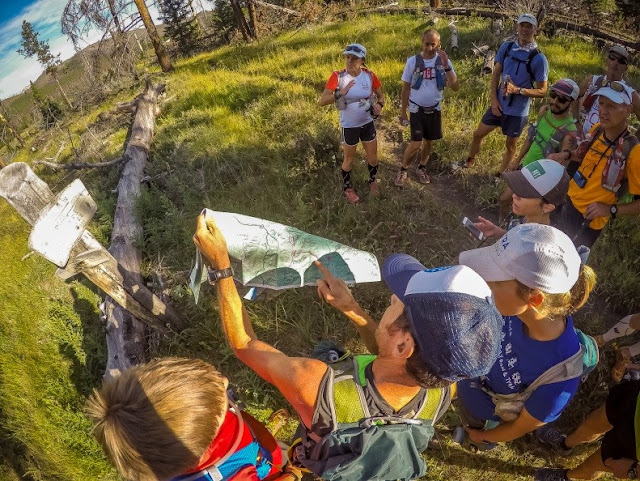 |
| Credit: Vo von Sehlen |
The Gang
Among the many things to love about this run is the assortment of people who end up at the start and how they all get connected. There were the three-peat veterans, names synonymous with Missoula running – Ken Ellis, Dean McGovern, Tim Mosbacher and Jared Oyler. Each of these guys now has run over 150 miles in the Bob over the last three summers. Several others who always are up for trail adventures all year long – Justin Grigg, John Fiore, Allison Onstad, Renate Bush, Mark Munro, Vo von Sehlen, Tod Bachman and of course JB Yonce. Others who got word second or third hand and took the plunge – Joran Elias, Erin Clark, Sally Cannata, and Milton Zhinin. Rounding out the runners were two medical residents new to town, but very accomplished runners Christi Nowak and Ethan Richards. And most importantly, the support crew (more on them later).
Following the tradition of the last three years, we caravanned out of Missoula early Friday afternoon. We headed first to the mandatory stop at the Buckhorn Bar in Augusta to see if they’d run out of chicken dinners yet (they hadn’t). We next stopped briefly in Choteau for supplies, gas, and a glimpse at the fiddlers in the back of a semi, then turned west toward the jagged line of peaks that form the Rocky Mountain Front.
Headquarters Pass By the Dawn’s Early Light
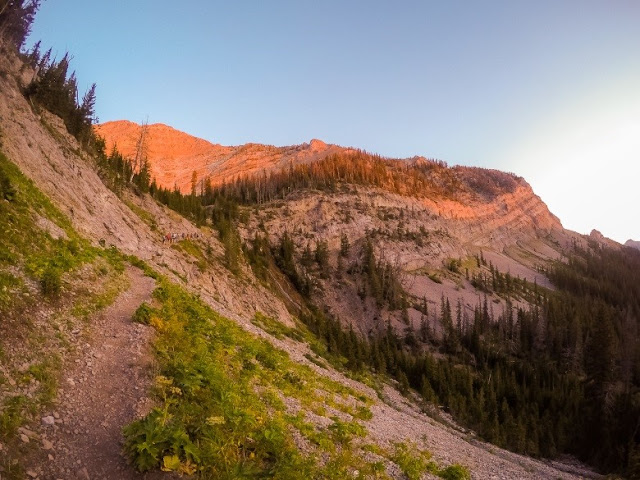 |
| Credit: Vo von Sehlen |
Thirty miles west of Choteau, the road up the South Fork of the Teton River dead-ends hard against the aptly-named Sawtooth Range. From the air (or in my case, hours spent manipulating Google Earth), the Sawtooths are a series of massively layered rocks tilted west and sheared off in jagged faces to the east. Sort of like someone shoved a stack of books up a ramp. A geologist would call it imbricate thrust faulting. Everyone else calls it stark, beautiful and slightly daunting when approached from the east. It’s almost impossible to enter the mountains more dramatically.
After crawling out of our little Forest Service campground in the dark, we were at the trailhead by 5:00. We counting noses, switched on headlamps and immediately began to climb up one of the steep eastern faces. By 6, the sun rose out of the eastern plains. Its long rays bathed the barren mountains above us with soft pink light. With each turn the terrain became more tundra-like with only rocks, flowers and scrawny wind swept krummholz. After 2000 feet of steady climbing, we reached Headquarters Pass. The pass is a rocky notch that sits between two mountains – Rocky Mountain to the south and Old Baldy north. Rocky Mountain is the highest peak in the Bob and earns its rather bold name.
Five of the support crew joined us for the trudge up Headquarters Pass. After snapping some pictures, they shoved us over the edge to the west and turned back for their long loop up around Marias Pass and down the long Hungry Horse road. The rest of us now were committed to do whatever it took to get all of us across the next 45 miles, most of which none of us ever had seen.
From Headquarters Pass the trail drops into a long gradual valley that was scorched in the legendary 1988 fires and still bears its scars in silvery snags surrounded by vibrant adolescent new growth. Nine mountain goats greeted us, climbing the trail we were descending. The next 8 miles or so were very smooth and runnable and we quickly spread out as the air grew warm. Some of us began to feel the early inking that this was going to be a long day.
 |
| Credit: Vo von Sehlen |
At 12 miles we reached the bottom of Headquarters Creek where it dumps into the North Fork of the Sun. At that point we’d given back all the elevation we’d earned and now actually were at the lowest point of the whole run. We regrouped and crossed the North Fork of the Sun on a sturdy horse bridge and entered the series of meadows that form Gates Park. Gates Park is classic Bob Marshall country – wide grassy valleys filled with rich tall grass, surrounded by mountains on all sides. The Sawtooths now rose behind us to the east, the main spine of the Continental Divide our next destination to the west. Any other place in Montana the valley would be filled with cows and the cows would be in heaven. But there were no cows, nor other people, so we got that little slice of heaven all to ourselves, just like we did for most of the rest of the day.
The North Wall
From Gates Park we began our second big climb of the day, this time a long 8 mile, several thousand foot slog up Red Shale Creek. It now was mid-morning and warm. Again we spread out in little groups of threes or fours. The Red Shale drainage burned in 2013, during the first RATBOB run. Unlike the fire remnants in the run down from Headquarters Pass, these scars still are fresh. Trees jet black with soot and ashy soil underfoot. But the open vistas were great and there was pink fireweed everywhere. I had worried that this drainage would be hot and dry, but the more we climbed the more lush it became.
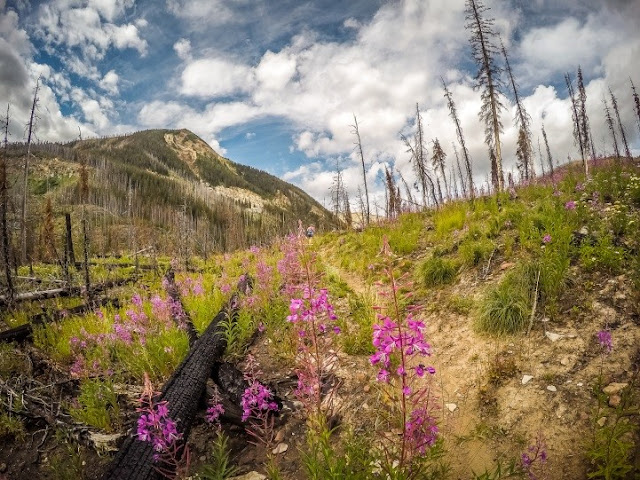 |
| Credit: Vo von Sehlen |
After about 7 miles of climbing, the trail grew steep, but we also reentered shady unburned forest, so it didn’t seem so bad. The trail slowly switchbacked up until we finally broke out into a beautiful meadow filled with flowers and backdropped by the huge yellow escarpment that forms the North Wall. It now was after 11:00 and we’d become pretty spread out, so we stopped for a long lunch break to regroup. The clouds gathered heavy on the wall and spit rain and the wind blew. No one said much about the weather, but it was on our minds, especially with only 20 miles down and more than 30 to go.
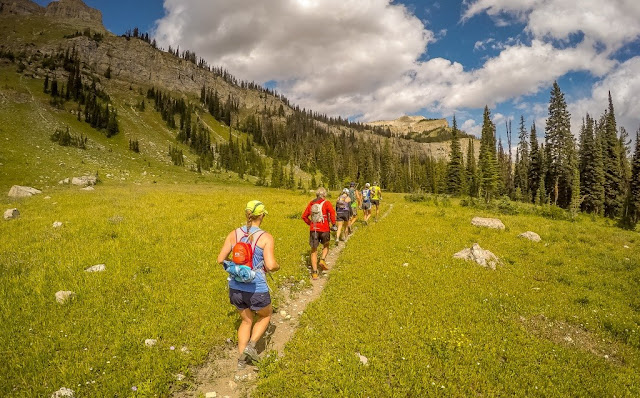 |
| Credit: Vo von Sehlen |
Every good run seems to have a heart and for this run the heart was the run along the North Wall. Up to Red Shale Meadows we’d mostly been traveling west, but now we turned north. The North Wall was our companion for 12 stunning miles after leaving Red Shale Meadows. It’s much wilder than the Chinese Wall, and every bit as spectacular. Like the Chinese Wall, the crest forms the Continental Divide. Our trail at its base is part of the rugged Continental Divide Trail that runs from Canada to Mexico.
From Red Shale Meadows, the trail climbed over a little pass, then down around the head of the first of four bowl-like drainages that poured east into the North Fork of the Sun. None of these passes or bowls is huge, but cumulatively the ridges began to take their toll as we rose and dropped 500 to 1000 feet in each drainage. The ravages of the 1988 fires still were quite evident in much of it.
Somewhere around the forks of Lick Creek, we passed 25 miles. Normally that feels like a milestone because the run is half over and the distance to the finish seems reachable. But it was hard not to think about the lack of any road within 25 miles either direction. Since leaving the shuttle crew a mountain range away, we’d yet to see another human the entire day. It’s moments like that when the realization hits of just how massive the Bob really is, and how insignificant a spread-out group of 19 runners feels. It’s sort of like swimming in across huge expanse of open water and realizing somewhere toward the middle that it’s still a really long ways to either shore and too far to turn back if something goes wrong. But there were wild strawberries and teeny whortleberries and flowers everywhere, so it was easy not to rush through the day. Somewhere around here, the ever resourceful Tod found the side trail up to Lake Lavale and swam in its icy waters, apparently thinking there was a swimming element to this run.
Three-quarters of the way around Open Creek, the last of the drainages, the trail split and our route went left and abruptly up. Straight up to the top of the Continental Divide. More than 1700 feet in about a mile, 32 miles into the run. With every step, the world became more alpine and the long views to the east and south even longer. After about 30 minutes of crazy climbing, we entered jumbled terrain filled with bright white limestone boulders. It was there we heard the crazy otherworldy yell that only could be John Hart. John had run in 18 miles or so from the other side and was perched up there in a high bolder field with an incredible vantage point. As each group of runners passed, John gave careful directions to follow the line of cairns at the ridgetop to the actual pass where the big descent into the South Fork of the Flathead River basin began.
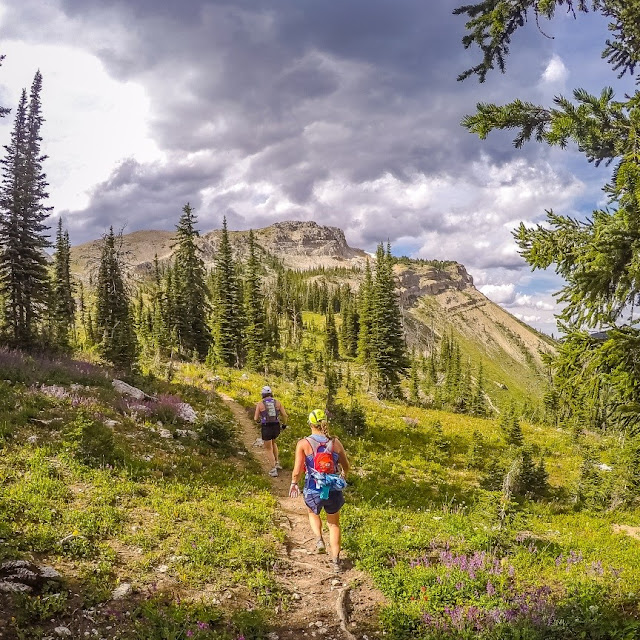 |
| Credit: Vo von Sehlen |
Switchback Pass to Silvertip
Once we crested, we ran north for about a mile along the high ridge to Switchback Pass. From there, a trail continued north into the Trilobite Range but we turned west. Our trail dropped steep and fast down the imposing southeast slope of Pentagon Mountain, into the Dean Creek drainage. John Hart warned us of a trail of endless switchbacks. According to my Strava track, we rounded at least 41 switchbacks, descending nearly 3,000 quad-burning vertical feet. It was dry too, though after a while we could hear running water and finally reached one of the forks of Dean Creek. There is no water like fresh cool water after it’s been rock-filtered and aerated off a virgin mountainside.
From the water crossing the trail leveled out and after a series of small climbs and descents, and a soothingly cool ford of the wide creek, we finally reached the Pentagon Cabin. Pentagon Cabin is a backcountry outpost that sits at the confluence of Dean Creek and the Spotted Bear River. This is where the lugnuts start to come loose and the trick was to finish the last 10 miles along the Spotted Bear River before wheels fell off. Pentagon Cabin also was the first time in 12 hours that we’d seen any other human other than crazy John Hart. It’s odd to explain the day to someone who just has spent equal amount of time backpacking less than a quarter of the distance.
From Pentagon Cabin to the trailhead is a smidgen over 10 miles. At 80 percent, it started to feel close and the daydreams kicked in. Wouldn’t it be nice to have a cold frosty beverage waiting at the trailhead? A plate of hot food, a campfire, a chair? Maybe some camp hosts to set up the tent? Irrational daydreams come toward the end of a run. Those 10 miles look easy on the map since we’re running downstream in the Spotted Bear River canyon. But they’re deceptively hard. Numerous times the trail climbed up on the hillside, then plunged back down toward the river. Climbs that we had run earlier in the day now became walks. Runs became the characteristic ultra-shuffle. But like the rest of the run, this stretch too had its charms. Afternoon heat gave way to the soft cool evening and its golden light illuminating the Limestone Wall above us. We passed over the roaring Dean Falls, then the wilderness boundary sign, and eventually got to the two iridescent blue lakes. Finally as all the Garmins clicked past 50 miles we arrived at the junction for the last little kick-butt climb up the trailhead.
Superheroes
We began to realize again the full measure of what the support crew means to this run. Earlier on the Spotted Bear trail Brian Fruit and Craig Macholz greeted us with enthusiastic high fives and bags of goodies. All they had done during the day was run up and down Headquarters Pass, drive 250 miles to the other end, find a campsite, and get the food unpacked, then run in 10 miles to be a mobile aid station. Dana Bandy, Ross Carlson and Jen von Sehlen met us at the trailhead with more food and coolers of cold drinks. It was like reaching the ultimate aid station, but it only got better. From the trailhead it’s a dusty half hour drive to the Spotted Bear campground. We arrived to an amazing sight. All the tents were set up. Amanda Dawsey was there with a huge spread of hot food and more drinks, far more calories than we could ever devour, though we gave it a good shot. For the next several hours we sat around the fire, told the stories of the day, plotted next year’s adventure, ate, drank and ate some more. You couldn’t ask for a better finish anywhere. All this the handiwork of Brian, Craig, Dana, Ross, Jen and Amanda, six truly amazing people who volunteered to do this. Sometimes even daydreams come true.
The Bob Marshall run has become like no other. No one takes home medals. There are no FKTs. The pictures matter more than the elapsed time or elevation gain. It may not be as constantly spectacular as the vertical rocks of Glacier or the Bitterroots, but in its own way it’s far wilder and starts to feel like it’s our own secret spot. It’s stunning to me that we could run through terrain like that and not see anyone for miles on what has to be one of the prime weekends to be out there. But what makes this run really special is how the comradery of the group melds itself to the wildness of the terrain such that we become part of it for the brief time we get to visit. There are so many people to thank. The runners, the crew, those who supplied us with home cooked food (Amy Brown and Margie Menendez), loaned us stuff (Kevin Twidwell, Runner’s Edge), and families that let us get out there for a Montana weekend.







 missoulamarathon.org >>
missoulamarathon.org >>